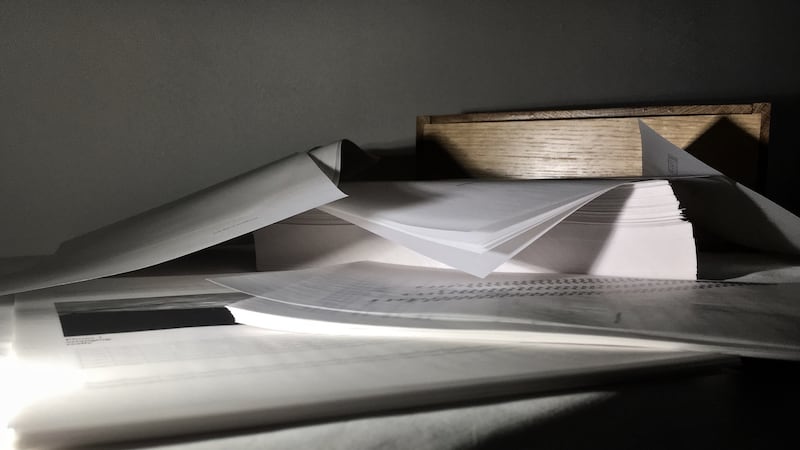My latest publication, MOTHERBABYHOME, is a 796-page “report” comprised of conceptual and visual poetry about the St Mary’s Mother and Baby Home in Tuam, Co. Galway. MOTHERBABYHOME is an excavation of voices: the poems are composed entirely of text taken from historical archives, contemporary media, and other sources related to the Home, including files given to me by Catherine Corless.
The source material dates from the construction of the building in 1841 as a workhouse to February 17th, 2019, when the Commission’s final report was due. The 796 poems are printed on transparent vellum and held in a handmade oak box. MOTHERBABYHOME is also available in a reader’s edition book.
When the Tuam story broke, I felt that the children and women who had lived, worked, and died at St Mary’s had quite literally been submerged in the landscape and archive of the Home. The physicality of the language on the page felt vital to me, as bodily autonomy was what these women and children were denied.
I began working with the emerging textual material that the story produced, intervening in, exposing, and clarifying the unfurling text as it appeared in the press and in the archive. This included reactions that sought to undermine the truth as it came out, suggesting the stories were a kind of “Catholic bashing”. I set up a Tuam Mother and Baby Home Google alert to gather the material more systematically. I soon realised I was going to need to write 796 pages as writing a single poem about this catastrophic and extraordinary situation felt insufficient. As a poet, I am preoccupied by these questions: what does it mean to write poetry in the face of human brutality and destruction? What is poetry for in these contexts? Who is it for? What can it do? What form should it take? These questions have underpinned my approach to MOTHERBABYHOME.


There are three poets whose work has been a touchstone for me throughout the writing process: HD’s Trilogy (1945-46) on the second World War, written in London during the bombings; M Nourbese Philip’s Zong! (2008) about the Gregson vs Gilbert decision regarding the murder of more than 130 enslaved people by the crew of the slave ship Zong; and Thomas Kinsella’s Butcher’s Dozen (1972), which addresses the Widgery Report on Bloody Sunday.
HD re-installs the poet to the status of ritual maker, re-instating poetic language’s capacity to act as a lasting performative spell: “we take them\ [poems] with us beyond death” as poetry is “magic, indelibly stamped / on the atmosphere somewhere”. While HD’s work instills this sense of poetry’s vitality in the face of the horrors of war, I am also drawn to M Nourbese Philip and Thomas Kinsella’s borrowing from, questioning, and re-making of legal language.
Kinsella’s poetic intervention reveals and rejects the sleight of words found in the Widgery Report. Likewise, using language taken from the Gregson vs Gilbert decision on the murder of enslaved Africans in 1781, in Zong! Nourbese Philip re-shapes the actual words of the case. She reveals how the supposedly rational language of the law can be used to justify and enable enormous violence, and she shatters and re-forms this same legal language in order to remember the act of killing and to mourn the dead. Kinsella and Nourbese Philip caution us from thinking that there is anything inherent in the language of the law and institutions that will protect or save us.
The poet must lay bare this fact and reshape that language into something else, into something that can give an account of, mourn, love, and re-make. This understanding was vital for me in the development of MOTHERBABYHOME, which I hope goes some way toward a poetics of transformational accountability as practiced by HD, Kinsella and Nourbese Philip.

On the one hand, the language surrounding Tuam is mired in legalese, in administrative evasions, in the church and state's contortions, backtracking and even plámásing. On the other, there is the absolute directness and clarity of the language of Catherine Corless, and increasingly, the shattering imagery of the survivors' testimonies, the sharing of which, often for the first time, is its own kind of revolution in language. What I'm trying to do through the found and visual poems in MOTHERBABYHOME is bring these voices into direct contact with one another with heightened intensity and urgency. The final seventy pages are devoted to the word 'delay' - the unceasing delays - delays of the Commission's reports; delays of investigations, excavations, and identifications; delays of admissions, apologies, and accountability. Delays of justice. Delays of love.
Kimberly Campanello is programme leader for creative writing and a member of the Poetry Centre in the School of English at the University of Leeds. On April 24th she will read the entirety of MOTHERBABYHOME between 5pm and 8pm at the Oonagh Young Gallery, 1 James Joyce Street, Dublin. All are welcome to come and go throughout the durational performance. More info www.zimzalla.co.uk


















